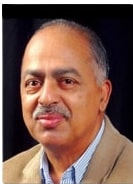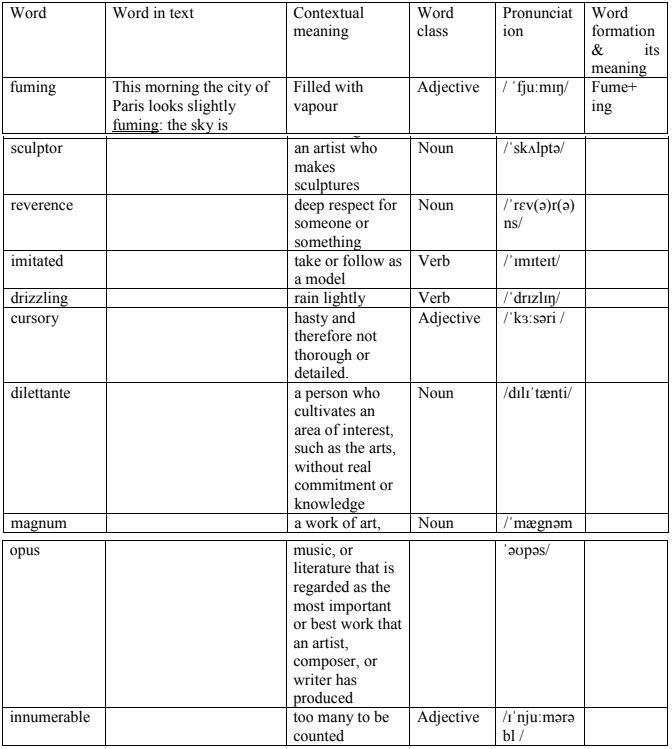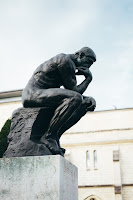Class 10 English Unit 4 Reporting Commands Exercise (Memoirs of my visit to France Class 10 Exercise)
Who is the writer of memoirs of my visit to France?
Govinda Raj Bhattarai is the writer of Memoirs of my visit to France. He is an essayist, novelist and literary critic. He has also worked as a translator. He is considered the first person to get PhD degree in translation studies. He has done a great contribution in the field of English literature living in the land of Nepal. His literary works include Muglan, Letter from Manipur, Socrate's footsteps, Socrate's diary and many more.
His contribution to Nepali literature cannot be neglected too. He has translated several literary books from English to Nepal and vice versa. His major translations include: Selected Stories from Nepal, Selected Nepali Essays, Stories of Conflict and War, Declaration of New Gods', Gandhi and Great Minds on India.
1. Vocabulary in use
i. Read the text again and describe the following words.
Word in the text: Most literary movements developed from the western movements of art and philosophy. They are entrenched firmly.
Answer=>
Read the table and group it into synonyms and antonyms
|
Main words
|
Synonyms
|
Antonyms
|
|
mustered
|
gathered
|
scattered
|
|
consequence
|
result, output, effect
|
NA
|
|
ascend
|
mounted up
|
declined, descended
|
|
magnificent
|
splendid, glorious, outstanding
|
NA
|
|
replica
|
copy, duplicate
|
original
|
|
swiftly
|
fast, quickly
|
undyingly
|
|
suffocated
|
crowded, congested
|
open
|
|
pensive
|
serious, sober
|
negligent
|
|
remarkable
|
noticeable, impressive
|
general
|
iii. Find the meaning of unfamiliar words from the text using a dictionary.
observation: the act of making and recording a measurement
entrusted: put into the care or protection of someone
trend: the popular taste at a given time
originated: come into existence; take on form or shape
symbolism: an artistic movement in the late 19th century that tried to express abstract or mystical ideas through the symbolic use of images.
claustrophobic: suffering from claustrophobia; abnormally afraid of closed-in places .
iii. Prepare a list of unfamiliar words from the text and
find their meanings in the dictionary:
List of Difficult words
fuming, overcast, drizzling, vicinity, emboldened,
cursory, connoisseur,
sculptor, dilettante, awe, reverence, magnum opus,
exceedingly,
imitated, innumerable
Meanings of these difficult words
fuming: furious, filled with smoke; overcast: cloudy
drizzling: light rainfall vicinity: nearby area,
local area
embolden: encourage, make
strong cursory: brief, superficial
connoisseur: expert sculptor:
artist
dilettante: amateur awe:
wonder, fear
reverence: respect, worship magnum opus: masterwork
exceedingly: extremely imitated: copied,
reproduced
innumerable: countless, numerous
2. Reading comprehension
i.Read paragraphs 1, 2 and 3 and state true or false.
Example: It was drizzling in the city of Paris in the morning. true
a. Paul Cézanne is an impressionist painter.
=> False
b. The author plans to give a cursory glance at museums.
=> True
c. He was assigned an Academy Project entitled Introduction to the Literary Trends and Movements.
=> Not given
d. The author has no words to express how he felt upon seeing the Mona Lisa in Rodin.
=> False
e. Paris has as many museums as temples in Kathmandu.
=> False
f. The author decided to visit Monet's Museum on the first day of his tour.
=> Not given
ii. Read the paragraphs 4, 5, 6 and 7. Then, choose the correct ending for each statement
Example: Most new thoughts originated in France came to ..............
(vi) literature through art.
a. In his Academy project, the author had to present a glimpse of literary trends and movements of the world.
b. The author wrote briefly on new trends of art and their relationship with literature using secondary sources of information.
c. According to the author, most of the literature originated from art.
d. Bangdel's Muluk Bahira Ma is a magnum opus.
e. In Musée d'Art Moderne, one can look at the paintings of Braque and Picasso.
Endings
i. art.
ii. using secondary sources of information.
iii. a glimpse of literary trends and movements of the world.
iv. a magnum opus.
v. look at the paintings of Braque and Picasso.
vi. literature through art.
iii. Read the paragraphs 8 and 9, and complete sentences choosing the correct options.
a. The author visited the museum alone .
b. The author had to buy tickets from a vending machine.
c. If you get lost in France you have to use a map.
d. Hitler and the Jews was written by BP Koirala .
e. The author traveled for 30 minutes from the Paris Nord station to Vernon .
f. Govinda Raj Bhattarai thinks nobody knows him.
g. The author was afraid of confined spaces, so he felt suffocated while climbing the escalator.
Memoirs of my visit to France question answer
iv. Read the paragraphs from 10 to 14, and answer the following questions.
a. What was the weather like?
Ans: The weather was fuming and drizzling.
b. Where was Musee Rodin?
Ans: Musee Rodin was across a sharp bend in the street.
c. Describe the road as the author described it.
Ans: The road was broad but wet; Its sidewalks were lonely and desolate and were shaded by poplars and maples. There were tree leaves scattered in a colourful way.
d. Why did the author feel lonely and helpless?
Ans: The author felt lonely and helpless because no one cared about anybody; people did not want to speak to him. People passing by him did not attend to him, and they did not talk to him in English.
e. Why did the author buy a hand machine?
Ans: The author bought a hand machine to listen to the recorded voice explaining about the museum in the English language.
f. What was the garden like? Describe it briefly.
Ans: The garden was full of pointed shapes of fir and pine trees, giving the best proof of French topiary. Far away stood other trees like walnut, juniper and yew, birds chirruped from the top.
g. Describe Rodin's Thinking Man in a few sentences.
Ans: The Thinking Man squatted on a large and tall marble slab, in half-bent posture and pensive mood. This is one of the masterpieces in modern art, an incomparable work; Rodin's pensive mood is remarkable.
h. When did the author visit the museum in Baltimore?
Ans: The author visited the museum in Baltimore 3 years ago.
i. Where was the replica of Rodin's thinker man?
Ans: The replica of Rodin's thinker man is in Baltimore.
j. What was the theme of the brochure distributed at the metro station?
Ans: The theme of the brochure distributed at the metro station was to visit the Rodin Museum on the first day of the Paris Visit.
C.
Follow-up activities
1.
Work in a group. Make a list of places the author has described in his memoirs.
Describe them as the author did, and share your description among your friends.
1.
Paris
Nord Station was crowded and magnificent.
2.
Metro
Station was modern and impressive.
3.
Louvre
was incredible and impressive because there stood an incredible painting of the Mona Lisa.
2. Have
you ever visited any museums in your country? Describe what you saw there.
The National
Museum of Nepal (Rashtriya Sangrahalaya) is a popular attraction of the capital
city, Kathmandu. About a century old, the museum stands as a tourist
destination and historical symbol for Nepal. Being the largest museum of Nepal,
it plays an important role in nationwide archaeological works and development
of museums. For the residents of Kathmandu, the monument serves to relive the
battles fought on the grounds of Nepal. The main attractions are collection of
historical artworks (sculpture and paintings) and a historical display of
weapons used in the wars in the 18-19th century. The museum has separate
galleries dedicated to statues, paintings, murals, coins and weapons. It has
three buildings-Juddha Jayatia Kala Shala, Buddha Art Gallery and the main
building which consists of natural historical section (collection of species of
animals, butterflies and plants), a cultural section and philatelic section.
Source
Time for Grammar
Read each sentence and write a new sentence with the same meaning:
1) “Don’t wait”
He asked me not to wait.
2)“Remember to post the letter”
She reminded me to post the letter.
3)“Keep out of this room at all times”
Kripa warned me to keep out of those rooms at all times.
4)“Don’t shout”
Bill told Jane not to shout.
5)“Please don’t tell anyone what has happened”
Anuj asked me not to tell anyone what had happened.
6) “Open the door for her”
Tom asked her to open the door for her.
7)“Listen carefully”
Shabdik asked Prasikha to listen carefully.
Report the following sentences:
a) Eat more vegetables and fruits”, the doctor said.
The doctor advised me to eat more vegetables and fruits.
b) “Shut the door”, Dad said.
Dad asked me to shut the door.
c) Arnav said, “Thank you.”
Arnav thanked me.
d) The notice said, “Welcome to Manang!”
The notice welcomed us to Manang.
e)” Don’t drive too fast”, I begged him.
I begged him not to drive too fast.
f)” Fry it in oil”, she advised me.
She advised me to fry it in oil.
g)He advised me, “Don’t lend her anything.”
He advised me not to lend her anything.
C. Follow-up activity
Write any ten commands and ten exclamations
in your exercise book. Then report them to your friends in the class.
Sentences
that express commands
1. Go to the
library.
2. Please,
come here.
3. Please,
sit down.
4. Please,
speak up.
5. Turn on
page 67.
6. Keep
quiet.
7. Share
your ideas to your friends.
8. Finish
your homework.
9. Brush
your teeth twice a day.
10. Help
yourself with the food.
Sentences
that express exclamation
1. Wow, what
a beautiful house!
2. How nice!
3. That's
great!
4. That's wonderful!
5. How pretty!
6. What a
cute baby!
7. What a
day!
8. Yuk,
disgusting!
9. That is
really horrible!
10. Hurray,
we won the match
Listening
A. Engage
yourself
Look at
the pictures, listen to the poem quickly, and answer the following questions.
a. What
does the first picture show?
=> The
first picture shows a farmer planting something in the bare land.
b. What
does the second picture suggest?
=> The
second picture suggests a student learning in the classroom/room.
c. What is
the relationship between two pictures?
=> The
relationship between the two pictures is that sowing seeds is equal to
learning.
Class 10 English Unit 4 Reporting Commands Listening Exercise (With Audio file)
B. Study
time
1. Listen
to the poem, and find the rhyming words for the following:
Needs =>
seeds
bare =>
care
grow =>
snow
time =>
rhyme
spring =>
2.
Listen to the poem again, and complete the following sentences choosing the
correct alternatives.
i. The poem
is written by Eleanor Farjeon
ii. The
title of the poem is Knowledge
iii.
Students are the farmers with knowledge of seeds.
iv.
Students must plant seeds in the spring.
v. The poet
asks us to plant the seeds of knowledge in our mind.
C.
Follow-up activity
Listen
to the poem again, and note down the important points. Now, working in pairs,
discuss the points you have noted down and write the summary of the poem.
The poet compares the human being with a farmer and the
human mind with a meadow. A farmer likes to sow seeds and plant things and look
after it with care. A good farmer does not like to see bare land. The poet
wants to convey the same message that we should not keep our minds empty. Like
a good farmer, we should plant the seeds of knowledge in our minds, which will
grow and develop like the seeds and plants in a farmer‟s meadow. The seeds of
knowledge can be about nature or science, history, math, music and literature.
If we keep our minds busy through reading, we are sure to gain wisdom and
knowledge, but it should be done at the right time.
Speaking
A.
Engage yourself
1. Study
the grammar section of this unit, and copy some direct commands.
=>Leki,
give me your homework.
Brijesh, put your book down.
Shakti, wait for me.
Let the boys clear up this mess.
Bishnulal, finish your classwork
first.
2. Make a
list of the verbs used in the commands.
=> give,
put, wait, clear, finish
B. Time for speaking
1. Student A and B are talking about what their teachers asked them to do. 'A' directly quotes what the teacher said while 'B' reports them. Work in a group of three. Play the role of 'A', 'B' and the teacher.
Example: Science teacher/complete experiment
Science teacher: Complete your experiment first.
a.English teacher/describe village/town
Science teacher: Describe your village or town.
A: Our science teacher said, “Describe your village or town.”
B: Our science teacher asked us to describe our village or town.
b.Math teacher/solve problem Math teacher
A: Our Math teacher said, “Solve problem.”
B: Our Math teacher asked us to solve the problem.
c.Social teacher/help people in trouble
Social teacher: Help people in trouble.
A: Our Social teacher said, “Help people in trouble.”
B: Our social teacher asked us to help people in trouble.
d.Nepali teacher/compose a poem
Nepali teacher: Compose a poem.
A: Our Nepali teacher said, “Compose a poem.”
B: Our Nepali teacher asked us to compose a poem.
e. Health teacher/keep clean and safe
Health teacher: Keep clean and safe.
A: Our Health teacher said, “Keep clean and safe.”
B: Our Health teacher asked us to keep clean and safe.
2. Work in a pair. Play the role of 'A' and 'B' to make
some commands and
report them.
a.A:
Mrs Moore, submit this proposal by 3 p.m. to the company owner.
B: Her Boss commanded Mrs Moor to
submit that proposal by 3 p.m. to the company owner.
b. A: Sergeant, join earthquake relief
work.
B: The army commander commanded the
sergeant to join earthquake relief work.
c. A: Raju, serve the meal for all.
B: My father asked me to serve the
meal for all.
d. A: Search team, investigate and identify the criminal as
soon as possible.
B: The police officer ordered the
search team to investigate and identify the criminal as soon as possible.
f. A:
Use the medicine daily twice a day for 15 days.
B: The doctor suggested his patient to
use the medicine daily twice a day for 15 days.
Writing
A. Engage yourself
Read the following cooking recipe, and discuss the given questions in pairs.
a. What are the instructions about?
=>The instructions are about how to prepare vegetable momo.
b. Why do you think the instructions are presented in numbers?
=>I think the instructions are presented in numbers to show the sequence of actions.
c. Why are imperative sentences used in the text?
=>Imperative sentences are used in the text because the instructor wants us to do it.
d. What happens if we don't follow the instructions sequentially?
=>If we don't follow the instructions sequentially, we can't have the good taste of momo.
Time for Writing
Project work
Work in a group of four to six. Find any book written in English that is
interesting to you in your school library or anywhere. Read the book, and write
a couple of paragraphs about a book, and present them to the class.
Fun corner
Look at the sculpture of rodins thinking man, and write what you feel when
you look at it.
This sculpture is very attractive. It is pleasing for the viewers. It presents a vivid scene of
a man who is thinking deeply sitting alone on a giant stone. The art is very appealing: the face, body, look and posture of the man all are artistic and balanced. The candid presentation of the reality of human life can be understood from this sculptor. I feel this man is serious; he is in a difficult situation, and possibly he is planning for some ways out of the terrible situation. This sculpture is indeed a candid portrayal of life in the advent-grade society. It must be an award-winning sculpture.



